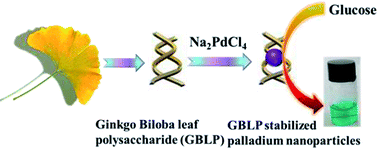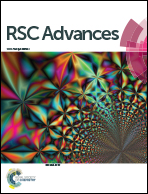Ginkgo biloba leaf polysaccharide stabilized palladium nanoparticles with enhanced peroxidase-like property for the colorimetric detection of glucose†
Abstract
Sensitive glucose detection based on nanoparticles is good for the prevention of illness in our bodies. However, many nanoparticles lack stability and biocompatibility, which restrict their sensitivity to glucose detection. Herein, stable and biocompatible Ginkgo biloba leaf polysaccharide (GBLP) stabilized palladium nanoparticles (Pdn-GBLP NPs) were prepared through a green method where GBLP was used as a reducing and stabilizing agent. The results of Pdn-GBLP NPs characterized by UV-visible spectroscopy (UV-Vis), Fourier transform infrared (FTIR) spectroscopy, transmission electron microscopy (TEM) and X-ray photoelectron spectra (XPS) confirmed the successful preparation of Pdn-GBLP NPs. TEM results indicated that the sizes of Pd NPs inside of Pdn-GBLP NPs (n = 41, 68, 91 and 137) were 7.61, 9.62, 11.10 and 13.13 nm, respectively. XPS confirmed the successful reduction of PdCl42− into Pd (0). Dynamic light scattering (DLS) results demonstrated the long-term stability of Pdn-GBLP NPs in different buffer solutions. Furthermore, Pd91-GBLP NPs were highly biocompatible after incubation (500 μg mL−1) with HeLa cells for 24 h. More importantly, Pd91-GBLP NPs had peroxidase-like properties and followed a ping-pong mechanism. The catalytic oxidation of substrate 3,3′,5,5′-tetramethylbenzidine (TMB) into blue oxidized TMB (oxTMB) by Pd91-GBLP NPs was used to detect the glucose concentration. This colorimetric method had high selectivity, wide linear range from 2.5 to 700 μM and a low detection limit of 1 μM. This method also showed good accuracy for the detection of glucose concentrations in blood. The established method has great potential in biomedical detection in the future.



 Please wait while we load your content...
Please wait while we load your content...